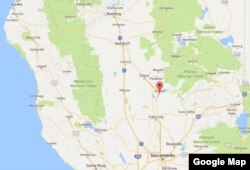Authorities lifted an evacuation order Tuesday for nearly 200,000 California residents who live below the nation's tallest dam after declaring that the risk of catastrophic collapse of its eroded emergency spillway had been significantly reduced.
Butte County Sheriff Kory Honea announced that people could return home immediately. Officials said they have drained enough of the lake behind Oroville Dam so that the emergency spillway will not be needed to handle runoff from an approaching storm.
But, the sheriff said, the region 150 miles northeast of San Francisco would remain under an evacuation warning, meaning that residents must be ready to flee again if conditions worsen.
'Be vigilant'
Residents returning home "have to be vigilant," and "there is the prospect that we will issue another evacuation order ... if the situation changes," Honea said.
Rod Remocal of Biggs, west of Oroville, said the announcement "took a big load off" of him. He called it "the thrill of relief."
The decision to lift the order came abruptly, just as the evacuation order Sunday night came shortly after officials said there was no threat.
The sheriff said water was being released through the dam's damaged primary spillway without further harm to the concrete structure. Work to cover the earthen emergency spillway with rocks and cement was on pace to beat the next rain, and those storms would be less potent.
"As a result of these actions, the risks that we faced when we initiated those evacuations have significantly been reduced," Honea said.
"This reduction to an evacuation warning properly balances the need for people to resume their daily lives while at the same time being prepared to deal with future increased threat," he added.
The decision came as helicopters carried giant sandbags and cement blocks from a staging area on the south side of Oroville Dam toward the stricken spillway on the north side. Crews operating heavy equipment loaded rocks and boulders into dump trucks, which carried them over the dam and dumped them on damaged portions.
Lower water rate
Bill Croyle, acting director of the state Department of Water Resources, said that as of noon Tuesday, water was flowing into the lake at a rate far lower than the water being released.
"That means we're continuing to make significant gains," Croyle said.
The surface of the reservoir was 12 feet lower than at its height, and the water release, described as the greatest in the dam's nearly half century, will continue to lower the surface a total of 50 feet.
The National Weather Service's Sacramento office said the incoming rain would move through late Wednesday and Thursday morning, with 2 inches to 4 inches expected in the foothills and mountains. But the storm was looking colder than initially projected, meaning less snow and less runoff than last week's storms.
Officials had ordered residents to flee to higher ground Sunday after concluding that the never-before-used emergency spillway was close to failing and sending a 30-foot wall of water into communities downstream.
Over the weekend, the rain-swollen lake spilled down the unpaved emergency spillway for nearly 40 hours, leaving it badly eroded. The problem occurred six days after engineers discovered a growing hole in the dam's main, concrete spillway.
Situation stabilizes
Officials defended the decision to suddenly call for mass evacuations Sunday, just a few hours after saying the situation was stable, forcing families to rush to pack up and get out.
"There was a lot of traffic. It was chaos," said Robert Brabant, an Oroville resident who evacuated with his wife, son, dogs and cats. "It was a lot of accidents. It was like people weren't paying attention to other people."
Oroville, a Gold Rush town in the Sierra Nevada foothills, is nestled near the foot of the dam, which was completed in 1968 and at 770 feet is the nation's tallest. Houses and churches are perched on tree-lined streets near the Feather River. Ornate Victorian homes sit alongside smaller bungalows.
Local businesses, including one that sells supplies for gold-panning, dominate a downtown area that spans several blocks. A wide range of chain stores sit a short distance away along the main highway.
The region is largely rural, with its politics dominated by rice growers, orchard operators and other agricultural interests. The region is dogged by the high unemployment rates endemic to farming communities. There are large pockets of poverty and swaths of sparsely populated forests that are popular with anglers, campers and backpackers.











